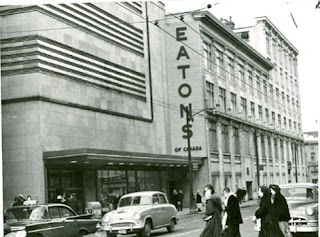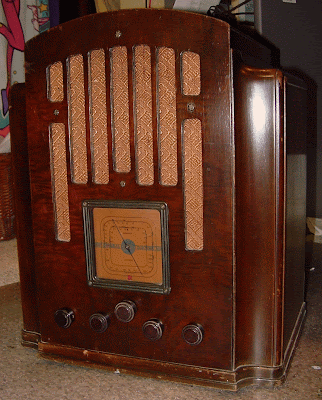 Hooked Early
Hooked Early
 |
| courtesy: http://www.arrl.org/ |
I still have a vivid memory of the day I discovered (and bought) my first QST magazine. It was in February, 1959, and I had recently turned 11 years of age.
It seems I was doomed from a very tender age and, as it turned out, there was little hope of recovery.
It was a Friday night and I had gone with my parents, as we did every Friday night following dinner, to the Eaton's department store in downtown Vancouver.
 |
| courtesy: http://www.thespec.com/ |
I recall debating to spend my small allowance on the costlier QST (55 cents) or the cheaper (40 cents) Popular Electronics. I found the technical-looking cover too overpowering, bit-the-bullet, and shelled-out for the QST ... that extra 15 cents forever sealing my fate.
As I sat in the back seat of the car (a '53 Chevy Sedan), waiting for my parents to finish their grocery shopping, I browsed through the QST. In truth, I understood very little but was particularly captivated with the station photographs in Rod Newkirk's "How's DX" column. One photograph in particular has remained in my memory through all these years, that of a young-looking "HS1JN" at the operating position from his exotic location in Thailand, along with Newkirk's equally enchanting description ... powerful stuff for a young mind eager to soak-up all of this new 'radio' stuff.
 |
| courtesy: http://www.arrl.org/ |
A recent internet search turned up snippets of information about the young Naval Researcher, Jamnong Saowanna, now SK, who eventually rose to the rank of Captain in the Thai Navy and was later instrumental in legitimizing amateur radio in Thailand. Apparently, back then, ham radio in Thailand had been unsanctioned and not officially approved by the government. HS1JN's original QSL also shows up, in the collection of K8CX, shown below.
 |
| courtesy: http://hamgallery.com/qsl/ |
Note that it's the same card shown taped to the front panel of HS1JN's homebrew transmitter in 1959. The K8CX card, for a 15m CW QSO with W6FMK in 1969, shows that OM Jamnong was by then running 500 watts along with a Collins KWM-2 ... quite a step up, but not nearly as alluring as his 'homespun 40-watt sender' and Hallicrafters S-40 receiver.
After absorbing as much as I could from my single copy of QST, I began making weekly visits to the downtown library via bus, every Saturday morning, as it was there that I discovered I could peruse their huge bound collection of QST magazines, and borrow the latest issues, just for the asking! As well, they had a stockpile of colorfully-covered Radio Amateur Handbooks that spanned the past two decades ... it couldn't get any better.
It was at this time that I changed my listening interests from the international shortwave broadcasters and began listening to hams on my old General Electric tombstone, particularly on 20m phone on weekend nights, as the band would be open all night long ... monster Cycle 19 had just peaked and propagation was nothing short of amazing.
Between the February QST and the old GE, I never really had a chance.














Steve I am with you on this one. I have QST going back into the 50’s as well and love looking at them to this day along with other mags like 73, CQ and of course some of the European mags. A few of the favorite covers for me were always the Christmas issue. I had doubles of a few of them and laminated the covers and put on my wall, those covers show a snow covered house and antenna , a radio room upstairs with the operator in front of his desk and smoke coming from the chimney. Takes me back to when I started with shortwave and my tube radios and that warmth they provided as well as the light from the tubes, now that was radio.
No doubt about it Fred, there was a lot more romance and magic back then when it came to radio. The ARRL did a great job of making ham radio very appealing. The world was a much larger place and just working someone a few hundred miles away or even just across town was exciting. It would be so cool to be able to turn back time and listen to the bands as they sounded in the 50’s … oh well :-((
73 Steve